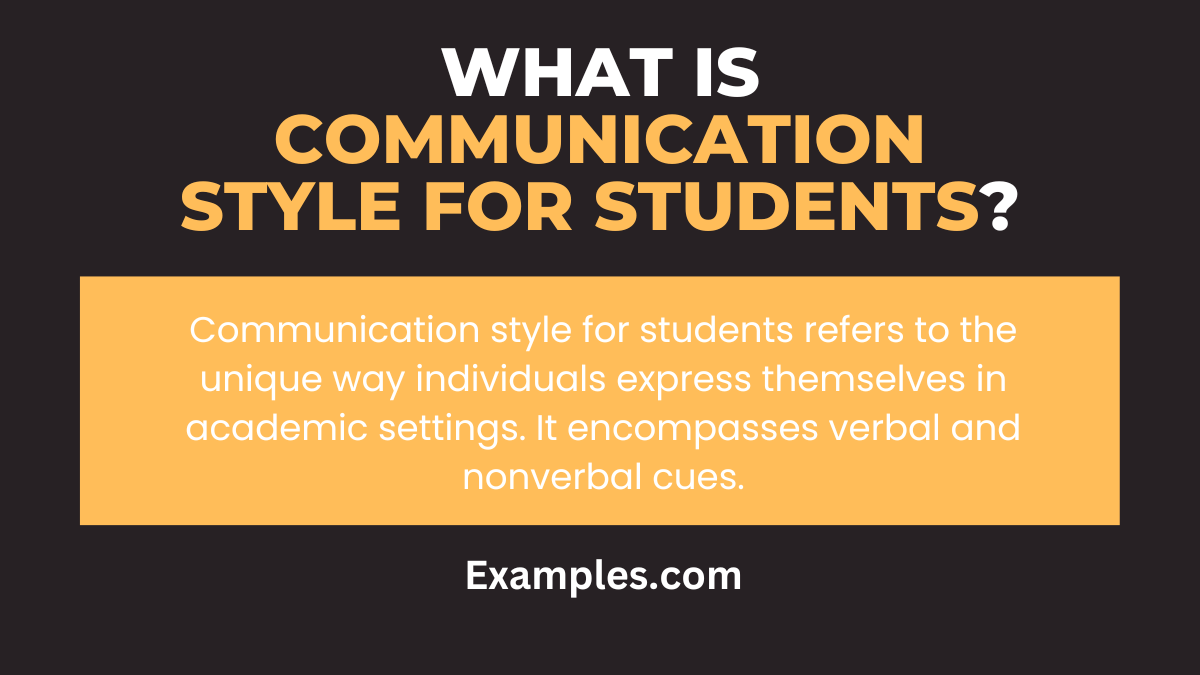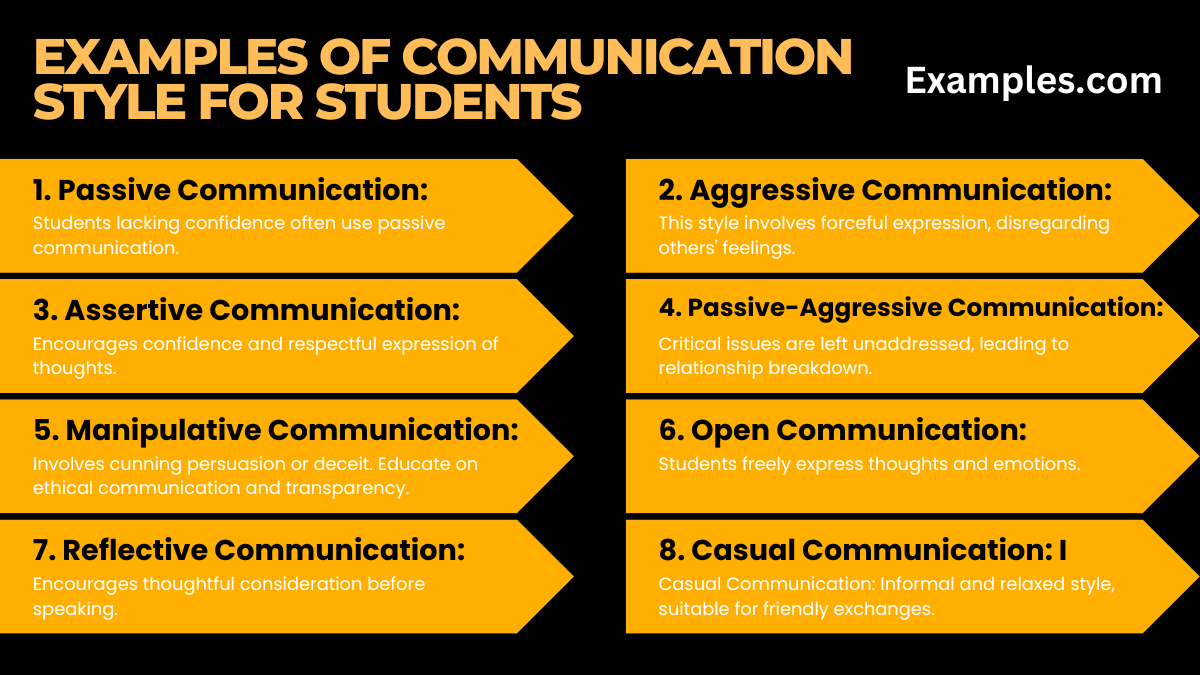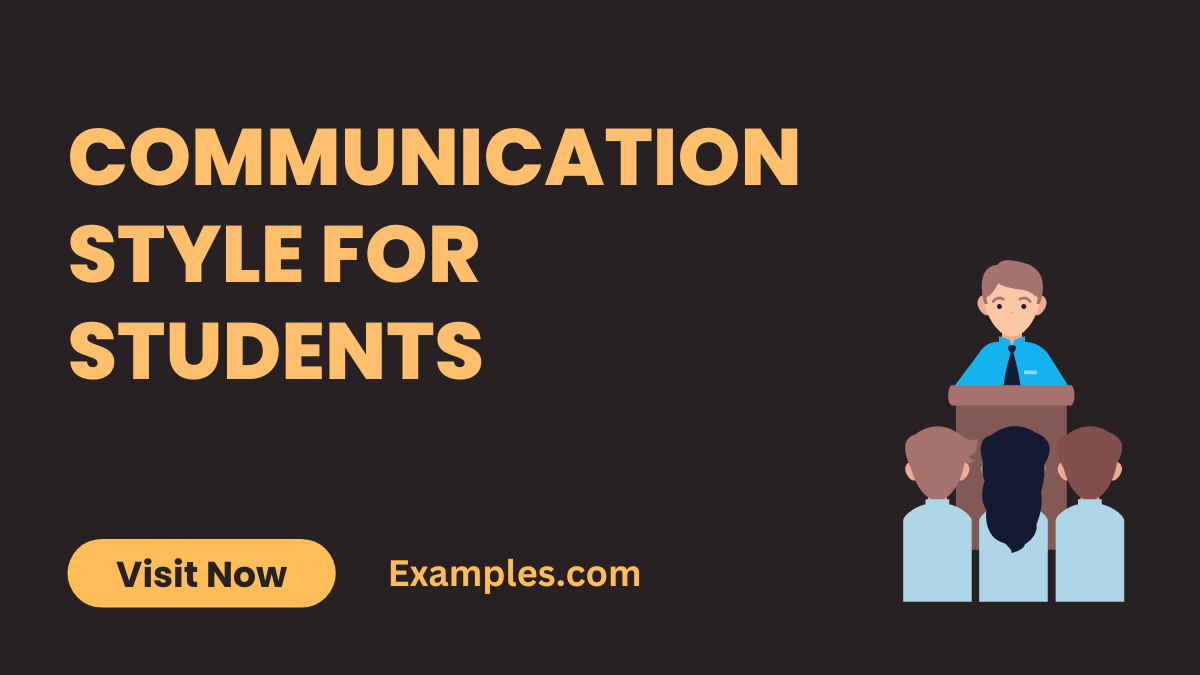9+ Communication Style for Students
Communication styles for students in this comprehensive guide. Navigating through the diverse landscape of verbal and nonverbal interactions, this guide delves into impactful communication examples that resonate within educational settings. Explore key strategies, understand the nuances of different styles, and enhance your student communication toolkit. Whether fostering collaborative learning or refining presentation skills, this guide provides valuable insights for students seeking to master the art of communication in academic environments.
What is Communication Style for Students?

Communication style for students refers to the unique way individuals express themselves in academic settings. It encompasses verbal and nonverbal cues, influencing how students interact with peers, teachers, and educational materials. In simple terms, it’s the distinctive approach students take to convey ideas, ask questions, and participate in classroom activities. Understanding one’s communication style is crucial for effective learning, collaboration, and overall academic success.
Communication Style For Students Essays Bundle

10 Examples of Communication Style For Students

Understanding various communication styles is essential for effective interaction, influencing both academic and personal realms. Here are ten distinct examples that showcase the versatility of communication styles, emphasizing their significance in relationships: Here are ten distinct examples:
- Passive Communication: Students lacking confidence often use passive communication, avoiding conflict but suppressing their needs. Encourage self-assurance to speak up.
- Aggressive Communication: This style involves forceful expression, disregarding others’ feelings. Teach empathy and active listening to mitigate aggression.
- Assertive Communication: Encourages confidence and respectful expression of thoughts. Promote active participation and constructive dialogues.
- Passive-Aggressive Communication: Students indirectly express resentment or opposition. Encourage open communication to address underlying issues.
- Manipulative Communication: Involves cunning persuasion or deceit. Educate on ethical communication and transparency.
- Open Communication: Students freely express thoughts and emotions. Foster an inclusive environment that values diverse opinions.
- Reflective Communication: Encourages thoughtful consideration before speaking. Guide students on self-reflection and mindful communication.
- Casual Communication: Informal and relaxed style, suitable for friendly exchanges. Teach context-appropriate communication.
- Collaborative Communication: Focuses on teamwork and shared decision-making. Cultivate cooperation and active listening skills.
- Written Communication: Essential for academic and professional settings. Offer guidance on clarity, structure, and audience consideration.
Communication Style For Students In School
Discover the nuanced communication styles students employ within the school environment. Enhance your understanding of verbal and nonverbal cues, fostering effective interaction.
- Participative Communication: Students actively engage in class discussions and collaborative projects, promoting a dynamic learning atmosphere.
- Inquisitive Communication: This style involves curious questioning, encouraging a culture of exploration and critical thinking among students.
- Adaptive Communication: Students flexibly adjust their communication based on diverse academic situations, optimizing their interactions.
- Leadership Communication: Focused on guiding and inspiring peers, this style empowers students to take on leadership roles in group activities.
- Visual Communication: Emphasizing the use of visual aids and graphics, students enhance comprehension in subjects like science and art.
- Debate-oriented Communication: Encourages structured arguments, refining students’ persuasive skills through organized debates and presentations.
- Technology-Driven Communication: Explores digital platforms, fostering communication skills through online collaboration, blogs, and virtual presentations.
- Collaborative Project Communication: Emphasizing teamwork, students navigate complex projects, enhancing problem-solving and communication in group settings.
- Extracurricular Communication: Beyond academics, students engage in diverse communication styles within clubs, sports, and cultural activities.
- Peer Mentorship Communication: Encourages supportive communication between students, creating a network for academic guidance and personal development.
Communication Style Quiz For Students
Elevate your self-awareness by exploring your unique communication style through this engaging quiz designed for students.
- Scenario-Based Quiz: Presents real-life situations to gauge how students would communicate, providing insights into their preferred styles.
- Visual Representation Quiz: Incorporates images and scenarios, allowing students to choose visual representations of their communication preferences.
- Role-Playing Quiz: Students immerse themselves in simulated conversations, identifying their natural communication tendencies through interactive role-playing scenarios.
- Multiple Choice Quiz: A straightforward yet effective quiz format, presenting students with options to select the communication style that resonates with them.
- Interactive Digital Quiz: Leverages technology with interactive elements, making the quiz engaging and accessible to a wide range of students.
Communication Style for Students at Home
Effective communication at home is crucial for students’ growth. It involves nurturing openness, respect, and active listening within family dynamics. Understanding and adapting communication styles in this environment aids in academic support and emotional development.
- Encouraging Communication: Fosters an environment where students feel comfortable sharing thoughts and concerns. How to Communicate: “I appreciate your thoughts. Can we discuss how your day went?”
- Supportive Communication: Emphasizes encouragement and validation for student endeavors. How to Communicate: “I’m here to help. Let’s work on your assignment together.”
- Constructive Communication: Focuses on providing feedback and guidance in a positive manner. How to Communicate: “Your effort in this project is commendable. Here’s a suggestion for improvement.”
- Boundary-Setting Communication: Defines limits while maintaining open dialogue. How to Communicate: “I value your privacy. Let’s discuss house rules for phone usage.”
- Collaborative Communication: Involves joint decision-making and problem-solving. How to Communicate: “Let’s brainstorm ideas together for planning our family weekend.”
What are the different communication styles for students?
Effective communication is integral to student success, yet the array of communication styles presents challenges. This guide delves into diverse communication styles for students, examining their influence on relationships, academic achievements, and personal growth. Exploring parallels with communication styles in the workplace and leadership, it seeks to uncover the most desirable approach to communication for optimal student development.
- Assertive Communication: Assertiveness promotes confidence and open expression. Students embracing this style often excel in group projects, contribute actively, and build lasting connections.
- Passive Communication: Passive students may struggle to voice opinions, hindering collaboration and personal growth. Recognizing and addressing passivity is crucial for a more engaged learning experience.
- Aggressive Communication: Aggression in students can lead to conflicts and hinder positive interactions. Strategies for channeling energy into constructive dialogue are explored to foster a more harmonious learning environment.
- Passive-Aggressive Communication: Recognizing and addressing passive-aggressive tendencies is key for preventing hidden conflicts that may negatively impact relationships among students.
- Collaborative Communication: Encouraging teamwork and shared decision-making helps students develop crucial social skills, enhancing their ability to navigate both academic and personal challenges.
Importance Of Communication Style For Students in School
Effective communication is the cornerstone of successful academic experiences. A student’s communication style significantly influences their interactions with peers, teachers, and the learning process as a whole.
- Fostering Positive Relationships: A tailored communication style contributes to building positive relationships. Students who express themselves clearly and respectfully are more likely to form strong connections with their peers and teachers.
- Enhancing Learning Opportunities: Communication style affects participation and engagement in the classroom. Students who feel comfortable expressing their thoughts are more likely to actively contribute, creating a dynamic learning environment.
- Conflict Resolution: Differences in opinions are natural in a school setting. A well-developed communication style equips students with the skills to navigate conflicts, fostering a constructive resolution process.
- Improving Academic Performance: Clear and effective communication is essential for understanding complex subjects. Students who can articulate their questions and seek clarification perform better academically.
- Building Confidence: A refined communication style builds confidence. Students who can communicate effectively experience a sense of empowerment, positively impacting their self-esteem and overall well-being.
How To Learn Communication Styles for Students?
Explore diverse communication styles for students, including verbal and nonverbal techniques. Enhance academic interaction, foster collaboration, and master effective presentation and listening skills for a successful learning journey.
How To Improve Students’ Communication in the Classroom?
Enhance student communication by fostering a supportive environment. Encourage active participation, provide constructive feedback, and incorporate interactive activities to promote effective verbal and nonverbal expression.
Why Its Importance Of Effective Communication Skills For Teachers
Teachers with effective communication skills create a conducive learning environment. Clarity, empathy, and responsiveness enhance student engagement, understanding, and overall academic success. Communication fosters positive teacher-student relationships.
Communication Style for Students: A Statistical Insight
Understanding the impact of communication styles among students is crucial for fostering effective learning environments. Let’s delve into compelling statistics that shed light on this topic.
1. Digital Communication Trends in Education: Recent studies from Edutopia reveal a significant shift towards digital communication tools in education. With 78% of students preferring online collaboration, mastering digital communication styles becomes paramount.
2. Influence of Communication on Academic Performance: Research from Harvard Education Review emphasizes the correlation between positive teacher-student communication and improved academic performance. Effective communication fosters a supportive learning environment, contributing to students’ success.
3. Role of Nonverbal Communication in Classroom Dynamics: According to American Psychological Association (APA), nonverbal communication accounts for a significant portion of human interaction. Understanding and utilizing nonverbal cues positively impacts classroom dynamics, creating a conducive atmosphere for effective communication.
4. Communication Styles in Collaborative Learning: A study published by Stanford Center for Teaching and Learning highlights the importance of varied communication styles in collaborative learning. Students engaging in diverse communication approaches demonstrate increased creativity and problem-solving skills.
As we explore these statistics, it becomes evident that effective communication styles significantly contribute to academic success. Embracing digital tools, understanding the influence of communication on performance, recognizing nonverbal cues, and promoting collaborative learning are essential aspects for students navigating the educational landscape.



